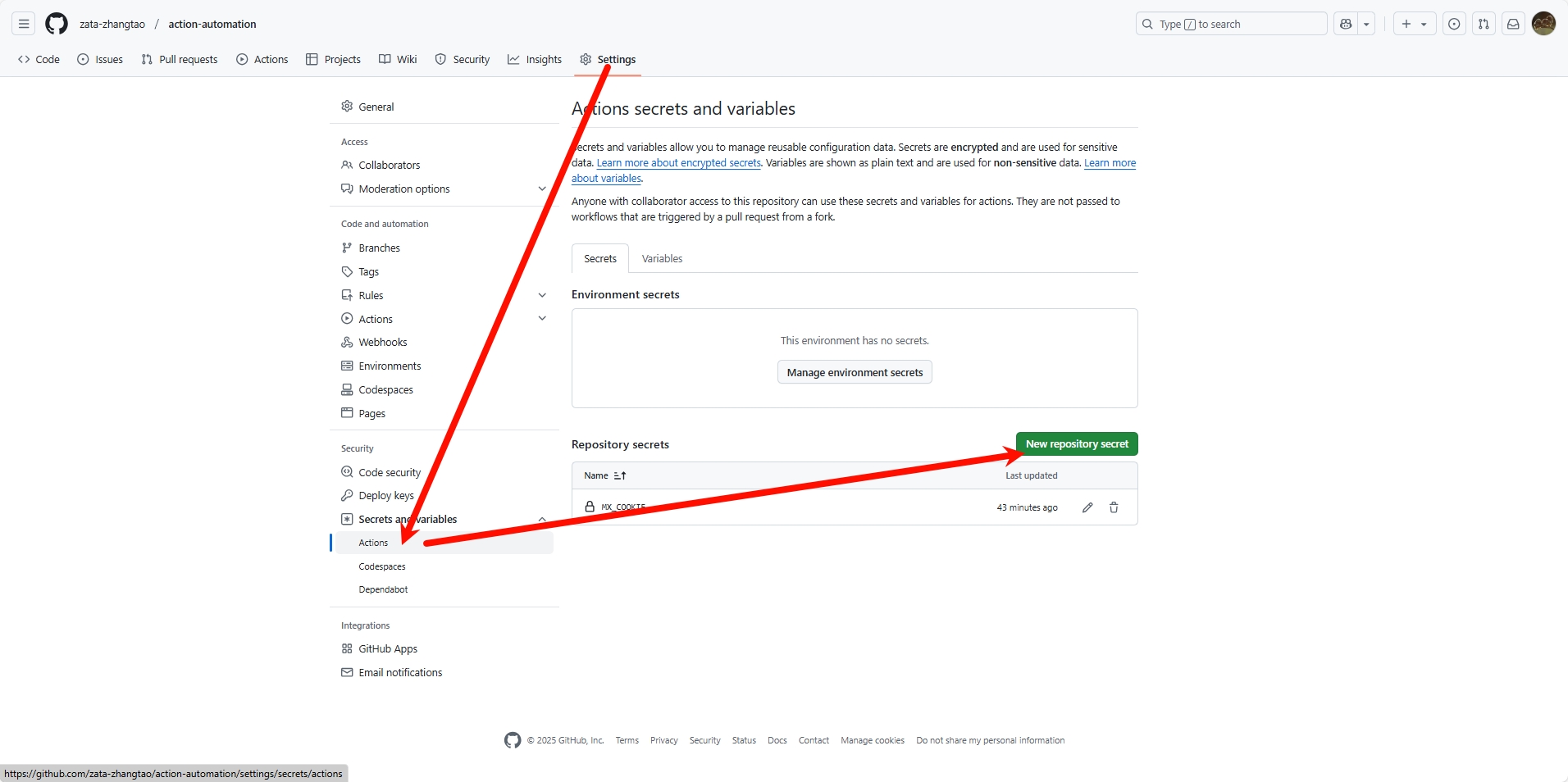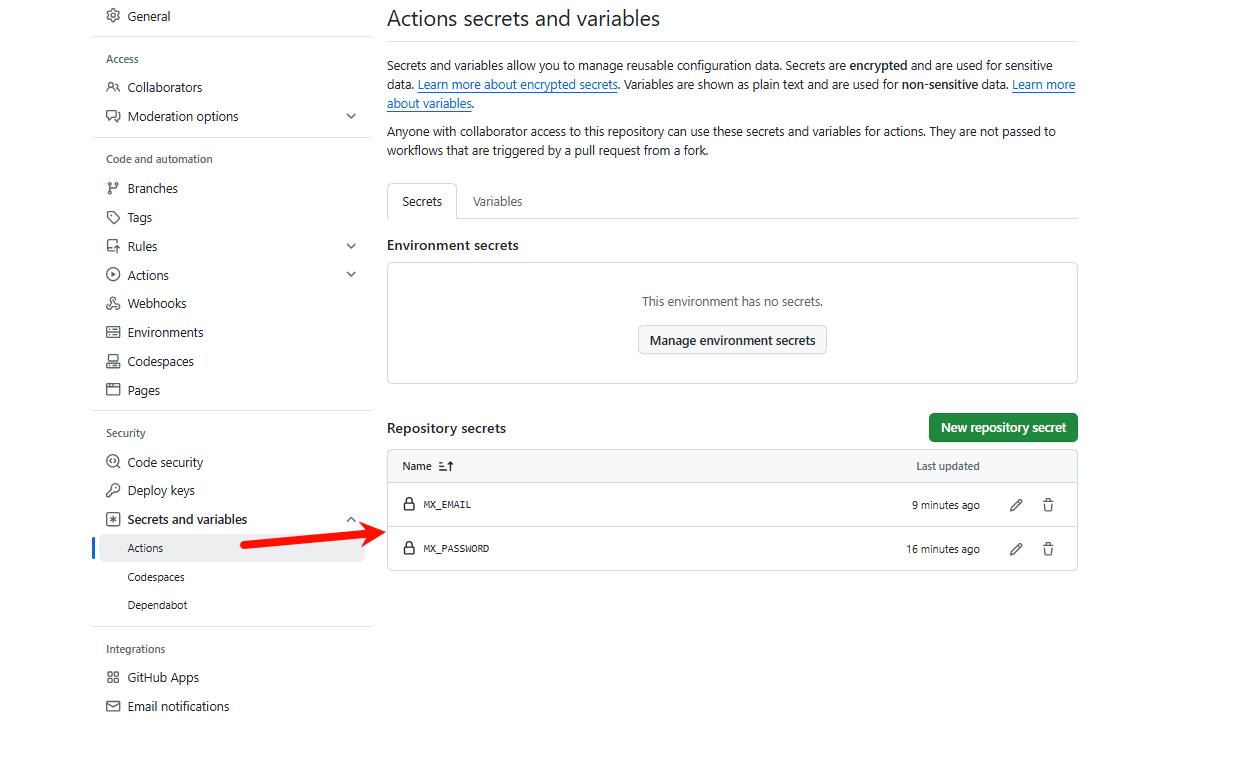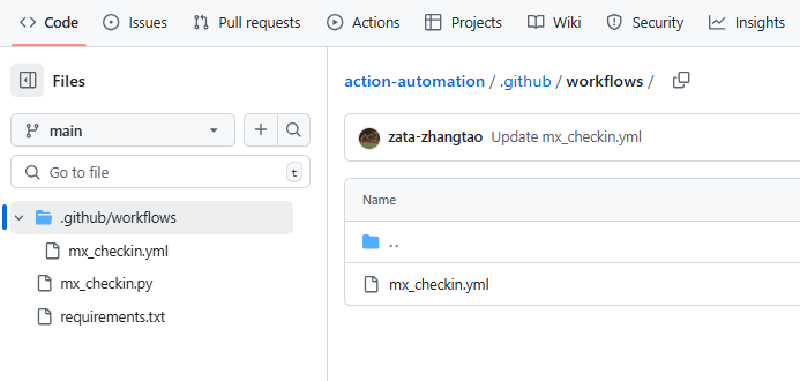 效果就是每天8点去自动签到
效果就是每天8点去自动签到

使用Cookie进行自动登录(简单,但是很容易因为Cookie过期而需要重新获取Cookie更新)
Cookie的获取
参考: https://www.diuber.com/cookie/
首先需要获取Cookie,这个Cookie是登录之后的Cookie,登录之后的Cookie是在浏览器的开发者工具中获取的,具体方法如下:
- 打开浏览器,登录mx的账号
- 打开浏览器的开发者工具,在Network中找到请求的接口,点击请求的接口,在Headers中找到Cookie,复制Cookie
签到的代码
# mx_checkin.py
import requests
import schedule
import time
from datetime import datetime
Cookie = os.environ.get("MX_COOKIE") # 把Cookie放置在action的环境变量中,例如这里是MX_COOKIE
# 签到函数
def checkin():
# 替换为实际的签到接口 URL
url = XXXXX
# 准备请求头(可能需要 Cookie 或 Token 来验证身份)
headers = {
"User-Agent": "Mozilla/5.0 (Windows NT 10.0; Win64; x64) AppleWebKit/537.36 (KHTML, like Gecko) Chrome/91.0.4472.124 Safari/537.36",
"Content-Type": "application/json",
# 如果需要登录凭证,可以在这里添加 Cookie 或 Authorization
"Cookie": Cookie,
# "Authorization": "Bearer your_token_here"
}
# 准备请求数据(根据实际接口要求调整)
data = {
"userId": "your-user-id", # 替换为你的用户 ID
"timestamp": int(time.time()) # 可选:发送当前时间戳
}
try:
# 发送签到请求
response = requests.post(url, headers=headers)
response_json = response.json()
# 检查签到是否成功
if response.status_code == 200 :
print(f"{datetime.now()} 签到成功:{response_json.get('msg')}")
else:
print(f"{datetime.now()} 签到失败:{response_json.get('msg')}")
except Exception as e:
print(f"{datetime.now()} 签到请求失败:{str(e)}")
# 脚本主循环
if __name__ == "__main__":
print("自动签到脚本已启动...")
# 首次运行时立即签到(可选)
checkin()
代码写好之后可以先在本地测试,保证测试ok
github action的工作流配置
关于github action的内容,可以查看我的文章 github action使用
# mx_checkin.yml
name: mx_checkin
on:
schedule:
# 此处是UTC时间,对应北京时间早八点
- cron : '00 00 * * *'
workflow_dispatch:
permissions:
contents: read
jobs:
build:
runs-on: ubuntu-latest
steps:
- uses: actions/checkout@v3
- name: Set up Python 3.12
uses: actions/setup-python@v3
with:
python-version: "3.12"
- name: Install dependencies
run: |
python -m pip install --upgrade pip
if [ -f requirements.txt ]; then pip install -r requirements.txt; fi
- name: Run checkin script
run: |
python mx_checkin.py
env:
MX_COOKIE: ${{ secrets.MX_COOKIE }}
requirements.txt
把需要的库写在这个文件中
requests
schedule
datetime
设置仓库密钥

把前面Cookie 填进去 粘贴过来的时候可以把引号去掉,我记得是不用加引号的,如果发现自己电脑上面测试可以,Action不行的话可以再试试加引号
上面的方法很受限于网站对于cookie的验证,如果网站对cookie验证过于严格,可以尝试下面的方法。
使用账号密码进行自动登录(复杂,但是可以避免Cookie过期的问题)
这里我只是给了一个简单的配置,很多网站登录的时候可能会多重验证,那就麻烦了….
找到登录的接口
当然每个网站不一样,不能一概而论

代码
# checkin
import requests
import schedule
import time
from datetime import datetime
import os
import json
from dotenv import load_dotenv
load_dotenv()
def refresh_cookie():
"""刷新 Cookie 的逻辑(需要根据实际网站实现)"""
global Cookie
try:
# 替换为实际的登录 URL 和登录数据
login_url = "https://mxwljsq.top/auth/login"
login_data = {
"email": os.environ.get("MX_EMAIL"), # 从环境变量获取邮箱
"passwd": os.environ.get("MX_PASSWORD"), # 从环境变量获取密码
}
print(login_data)
headers = {
"User-Agent": "Mozilla/5.0 (Windows NT 10.0; Win64; x64) AppleWebKit/537.36 (KHTML, like Gecko) Chrome/91.0.4472.124 Safari/537.36",
"Content-Type": "application/x-www-form-urlencoded"
}
# exit()
# 发送登录请求
response = requests.post(login_url, data=login_data, headers=headers)
print(response.text)
if response.status_code == 200:
# 假设登录成功后 Cookie 在响应头中返回
new_cookie = response.cookies.get_dict()
Cookie = "; ".join([f"{k}={v}" for k, v in new_cookie.items()])
print(f"{datetime.now()} Cookie 刷新成功")
return True
else:
print(f"{datetime.now()} Cookie 刷新失败:{response.text}")
return False
except Exception as e:
print(f"{datetime.now()} Cookie 刷新异常:{str(e)}")
return False
def checkin():
refresh_cookie()
global Cookie
if Cookie is None:
print("Cookie 为空,请先刷新 Cookie")
return False
url = "https://mxwljsq.top/user/checkin"
headers = {
"User-Agent": "Mozilla/5.0 (Windows NT 10.0; Win64; x64) AppleWebKit/537.36 (KHTML, like Gecko) Chrome/91.0.4472.124 Safari/537.36",
"Content-Type": "application/json",
"Cookie": Cookie,
}
try:
response = requests.post(url, headers=headers)
response_json = response.json()
if response.status_code == 200:
print(f"{datetime.now()} 签到成功:{response_json.get('msg')}")
return True
else:
print(f"{datetime.now()} 签到失败:{response_json.get('msg')}")
# 如果是登录失效,尝试刷新 Cookie
return False
except Exception as e:
print(f"{datetime.now()} 签到请求失败:{str(e)}")
return False
if __name__ == "__main__":
print("自动签到脚本已启动...")
# 加载本地 Cookie,如果没有则使用环境变量中的
# 首次运行立即签到
print(f"{datetime.now()} 开始执行签到任务...")
checkin()
# mx_checkin.yml
name: mx_checkin
on:
schedule:
# 此处是UTC时间,对应北京时间早八点
- cron : '00 00 * * *'
workflow_dispatch:
permissions:
contents: read
jobs:
build:
runs-on: ubuntu-latest
steps:
- uses: actions/checkout@v3
- name: Set up Python 3.12
uses: actions/setup-python@v3
with:
python-version: "3.12"
- name: Install dependencies
run: |
python -m pip install --upgrade pip
if [ -f requirements.txt ]; then pip install -r requirements.txt; fi
- name: Run checkin script
run: |
python mx_checkin.py
env:
MX_EMAIL: ${{ secrets.MX_EMAIL }}
MX_PASSWORD: ${{ secrets.MX_PASSWORD }}
设置仓库密钥

这里是肯定不需要加引号的,因为邮箱和密码都是字符串,加引号的话会被认为是字符串。(我试过了)
